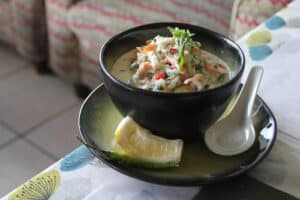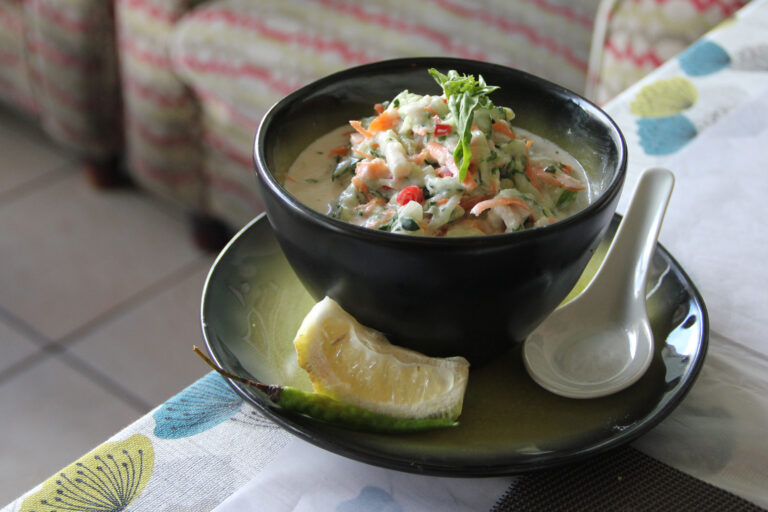
Welcome to our guide on Kokoda, Fiji’s national dish! In this article, we will explore the fascinating facts and history behind this beloved culinary tradition. Kokoda is a dish that holds great significance in Fijian culture, and its flavors and preparation methods have been passed down through generations. The preparation of Kokoda often involves fresh ingredients like coconut milk, lime, and a variety of seafood, making it a vibrant and refreshing dish. Additionally, exploring the lu pulu recipe and culture further highlights the importance of traditional cooking methods in Fijian households. As you dive deeper into these culinary practices, you’ll discover how they reflect the values and traditions of the Fijian people.
Originating from the coastal regions of Fiji, Kokoda is a dish that showcases the vibrant and diverse flavors of the Pacific Islands. It is a refreshing and tangy dish made with raw fish marinated in citrus juices, coconut milk, and a blend of aromatic herbs and spices. The combination of these ingredients creates a unique and delightful taste that is sure to tantalize your taste buds.
Our team at Remitly created this guide as part of our series that celebrates the traditional dishes of our global customers.
Traditional Preparation and Ingredients
Kokoda is traditionally prepared using raw fish, which is marinated in a blend of citrus juices, coconut milk, herbs, and spices. The dish is typically served cold and is a popular appetizer or main course. The fish used in Kokoda can vary, but the most common types of fish used are tuna, snapper, or mahi-mahi. The fish is typically sliced into small pieces and then marinated in lime or lemon juice for several hours, which helps to “cook” the fish and remove any undesirable flavors.
Raw Fish and Coconut Milk: The Key Ingredients
One of the key ingredients in Kokoda is coconut milk. This creamy ingredient helps to balance out the acidity of the lime or lemon juice and adds a smooth texture to the dish. Coconut milk is extracted from freshly grated coconut meat, which is then mixed with water and strained to create a rich, flavorful liquid. In addition to coconut milk, raw fish is also a crucial component of Kokoda. The freshness and quality of the fish used in Kokoda is important, as the fish is consumed raw.
Tangy Lime Juice and Fresh Vegetables
Lime or lemon juice is another essential ingredient in Kokoda. The acid from the citrus juice helps to “cook” the fish and gives the dish its signature tangy flavor. In addition to lime juice, fresh vegetables are also used in Kokoda to add texture and flavor. Tomatoes, onions, and chili peppers are commonly used to add a little bit of heat to the dish, while cucumber and bell peppers add a refreshing crunch.
Spicy Kick: Onions, Tomatoes, Chili Peppers, and Coriander
Onions, tomatoes, and chili peppers are popular additions to Kokoda, as they add a spicy kick to the dish. These ingredients are typically diced and mixed into the marinade, allowing the flavors to meld together. The heat from the chili peppers can be adjusted to suit individual preferences, making Kokoda a versatile dish that can be customized to suit a variety of tastes.
Coriander is a fragrant herb that is often used to add a burst of flavor to Kokoda. The leaves of the coriander plant have a slightly citrusy flavor that pairs well with the tangy lime juice and creamy coconut milk in Kokoda. Coriander is typically chopped and added to the dish just before serving to add a fresh, herbaceous note to the flavor profile.
Cultural Significance and Culinary Heritage
Kokoda is an important part of Fijian culture and heritage. The dish has been passed down through generations and is still a popular part of traditional Fijian cuisine today. Kokoda is often served during special occasions such as weddings, festivals, and other celebrations. The dish is a symbol of community and family, and its preparation and consumption are often accompanied by cultural rituals and traditions. Kokoda is a delightful gem of Pacific cuisine, and its rich history and cultural significance make it a truly special dish to experience.
Recipe: Traditional Fijian Kokoda
Ingredients:
- 1 lb fresh fish fillets (tuna, snapper, or mahi-mahi), sliced into small pieces
- 1 cup coconut milk
- Juice of 4 limes or lemons
- 1 small red onion, finely diced
- 2 tomatoes, diced
- 1-2 chili peppers, finely chopped (adjust according to spice preference)
- 1 cucumber, diced
- 1 bell pepper, diced
- Handful of fresh coriander leaves, chopped
- Salt and pepper to taste
Instructions:
- In a bowl, combine the fish pieces with the lime or lemon juice. Make sure the fish is fully submerged in the juice. Cover the bowl and refrigerate for at least 2 hours, or until the fish turns opaque and “cooks” in the citrus juice.
- In a separate bowl, mix together the coconut milk, diced red onion, tomatoes, chili peppers, cucumber, bell pepper, and coriander leaves. Season with salt and pepper to taste.
- Once the fish has marinated, drain the excess lime or lemon juice and add the fish to the coconut milk mixture. Gently stir to combine all the ingredients.
- Cover the bowl and refrigerate for another 30 minutes to allow the flavors to meld together.
- Before serving, give the Kokoda a final taste and adjust the seasoning if needed.
- Serve the Kokoda chilled as an appetizer or as a main course with steamed rice or crusty bread.
Enjoy the refreshing and tangy flavors of traditional Fijian Kokoda!
Learn More About Fijian Cuisine
Fijian cuisine is a reflection of the country’s rich cultural heritage and diverse influences. The cuisine of Fiji is a fusion of traditional Fijian flavors with influences from Indian, Chinese, and European cuisines. The result is a unique and vibrant culinary experience that showcases the best of the Pacific Islands.
One of the defining features of Fijian cuisine is its emphasis on fresh and locally sourced ingredients. With an abundance of tropical fruits, vegetables, and seafood, Fijian dishes are known for their vibrant colors and bold flavors. From succulent seafood curries to hearty root vegetable dishes, Fijian cuisine offers a wide range of options for every palate.
Coconut is a staple ingredient in Fijian cooking and is used in a variety of dishes. From coconut milk and cream to freshly grated coconut, this versatile ingredient adds a creamy and tropical touch to many Fijian recipes. Whether it’s used in curries, desserts, or refreshing beverages, coconut is a key component of Fijian cuisine.
Another popular ingredient in Fijian cuisine is taro. Taro is a starchy root vegetable that is used in a variety of dishes, including soups, stews, and side dishes. It has a mild, nutty flavor and a creamy texture when cooked. Taro leaves are also used in traditional Fijian dishes, such as palusami, where they are wrapped around a filling of coconut cream and cooked to perfection.
Fijian cuisine also features a variety of tropical fruits, such as pineapple, mango, papaya, and passion fruit. These fruits are often used in desserts, salads, and refreshing beverages. The sweet and tangy flavors of these fruits add a burst of freshness to Fijian dishes and are a true delight for the taste buds.
In conclusion, Fijian cuisine is a vibrant and diverse culinary tradition that showcases the best of the Pacific Islands. With its emphasis on fresh ingredients, bold flavors, and unique combinations, Fijian dishes are a true delight for food lovers. Whether you’re enjoying a traditional Kokoda or savoring a spicy seafood curry, Fijian cuisine is sure to leave a lasting impression. So, next time you have the opportunity, be sure to explore the flavors of Fiji and experience the culinary wonders of this beautiful island nation.
Visit the homepage, download our app, or check out our Help Center to get started.
